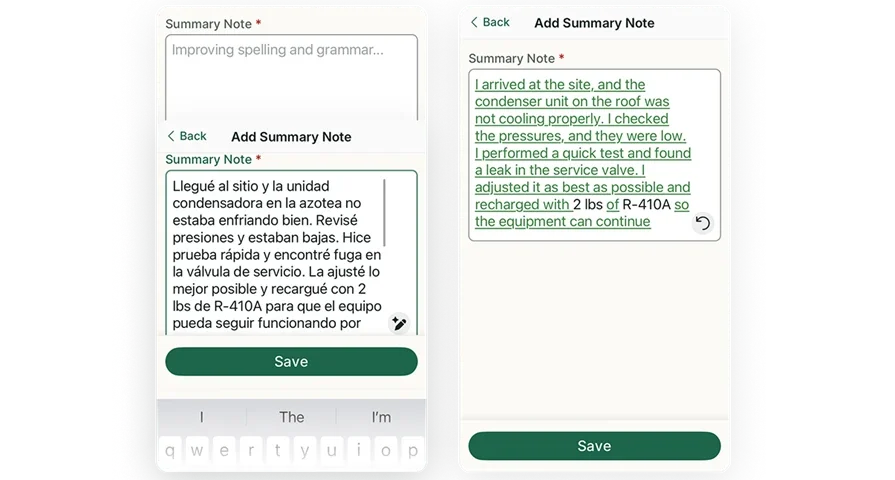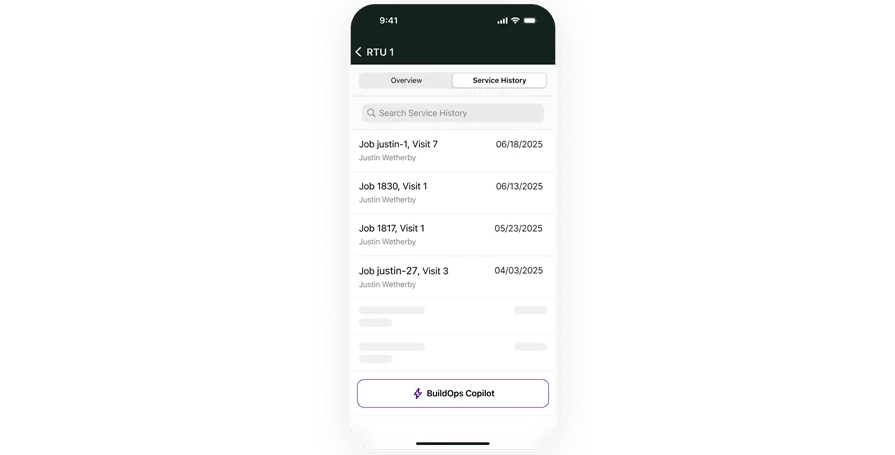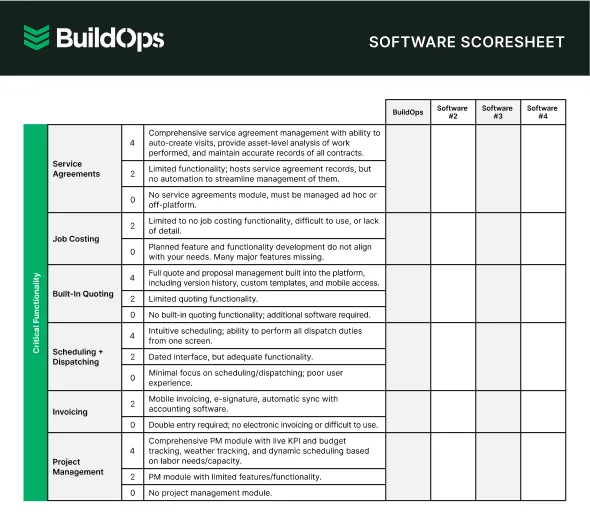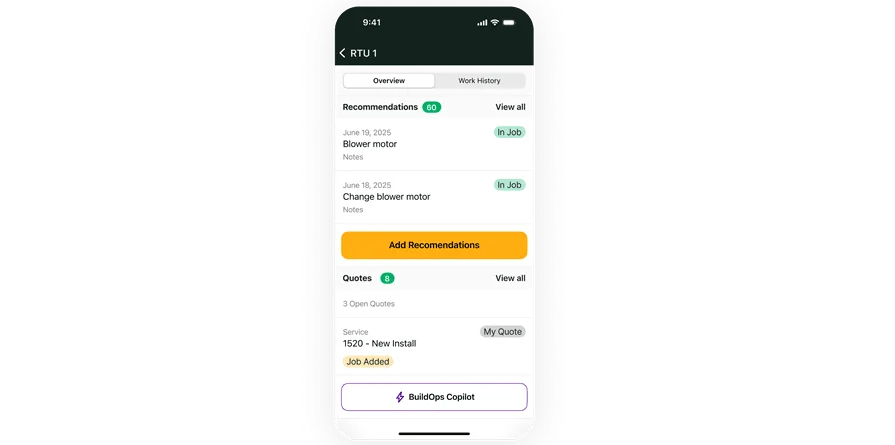Field service work is tough—tight schedules, unpredictable job sites, and constant pressure to get it right the first time. The ideal field service app doesn’t just make the job easier; it gives technicians the tools to handle tasks faster, communicate better, and stay on top of every job without the paperwork headaches.
From scheduling and dispatching to on-site diagnostics and reporting, these apps simplify the chaos and help crews stay sharp in the field.
Here’s what we’ll cover:
- How to choose the right field service app for your technicians
- Key field service app features to look for
- 10 best apps for field service management
- 7 benefits of field service apps
- 4 field service management app FAQs answered
Now, let’s get into how to choose the right field service app for your team—and what to keep in mind to make the best call.
How to choose the right field service app for your technicians
Choosing the right field service app for your technicians means giving them a tool that works as hard as they do. Field service isn’t predictable—jobs pop up last minute, equipment fails when you least expect it, and schedules shift on the fly. A solid app helps technicians stay on top of it all, whether they’re diagnosing an issue, updating job details, or tracking equipment on-site. Here are some key things to consider:
- Real-time communication - Can technicians communicate directly with the office while in the field? Does the app offer live status updates to keep dispatchers informed about job progress and unexpected delays?
- Job documentation in the field - Can techs easily log job details, upload photos, and capture customer signatures on-site? Does the app automatically store this information for future reference?
- Route optimization and GPS tracking - Does the app provide GPS tracking and suggest efficient routes? Can it adjust in real time to avoid traffic or reroute technicians to urgent jobs?
- Mobile accessibility built for the field - Is the app intuitive enough to use with gloves on, in direct sunlight, or in tough job-site conditions? Does it work smoothly on technicians’ existing devices?
- Features - What core capabilities does the app provide? Can it handle scheduling, dispatching, inventory tracking, and invoicing in one place? Are the features designed specifically to support field service workflows?
Selecting a field service app isn’t just about checking boxes; it’s about making sure your technicians can work faster and smarter without fighting the software. Next, we'll dig into the key app features that can make or break productivity in the field.
Key field service app features to look for
A field service app isn’t just a digital notepad—it’s a tool that keeps your technicians informed, efficient, and connected while they’re out on jobs. The right features help crews handle tasks more quickly, avoid mistakes, and provide better service to customers. Let’s break down some essential categories of field service app features and what to look for in each.
Features for apps built for technicians on the job
When you’re out in the field, every second counts. An app built for technicians should help you handle the job without delays or confusion. From pulling up job details to documenting completed work, these features help techs stay sharp:
- Real-time job updates - Imagine this: you're halfway through an equipment inspection when dispatch calls with an urgent repair request across town. A good app should be able to instantly update your schedule and provide the job details, location, and customer notes without a phone call or a trip back to the office.
- Mobile-first interface - Ever tried scrolling through tiny text while standing on a rooftop under the sun? A mobile-friendly app for technicians uses larger buttons, simple menus, and dark-mode options to stay visible and easy to use—even when you're juggling tools and wearing gloves.
- Photo and signature capture - After replacing a faulty compressor, you snap a photo, log your notes, and get a customer’s signature—all directly in the app. No paperwork to lose, no extra time back at the office. This documentation also protects your team if there's a future dispute.
- Offline functionality - Picture a technician inspecting HVAC units in a basement parking garage where cell signals disappear. With offline access, they can still view the job details and log their work. The app syncs it all to the system automatically when back above ground.
These features turn a smartphone into a technician’s best assistant—always ready, always reliable.

Explore our mobile tech app
Every BuildOps feature in the hands of your techs.
Features for apps focused on diagnostics and troubleshooting
Diagnosing equipment issues in the field can feel like solving a puzzle—especially when you're dealing with unfamiliar systems. Diagnostic and troubleshooting apps should assist techs with real-time data and step-by-step guidance to speed up problem-solving. Key features include:
- Interactive equipment manuals - You're standing in front of an industrial chiller you've never seen before. Instead of guessing, you open the app, search the model number, and pull up wiring diagrams, pressure settings, and maintenance history. No more flipping through bulky manuals or calling the office for help.
- Sensor integration for live diagnostics - A customer complains about inconsistent airflow, but the system seems fine at first glance. With sensor integration, you run live diagnostics and discover the blower motor's running at half power. This saves time and helps you solve the problem on the first visit.
- Step-by-step troubleshooting guides - New hires often struggle when faced with unfamiliar issues. An app with built-in troubleshooting workflows walks them through the process, like a digital mentor, reducing errors and boosting confidence on tough jobs.
- Remote diagnostics capabilities - Your dispatcher gets a call about a rooftop unit acting up. Before sending a technician, they access the app, connect to the unit’s sensors, and identify the likely cause—a clogged filter. This means techs arrive with the right parts and tools, instead of guessing.
These features help technicians troubleshoot like pros, even when they’re dealing with unfamiliar equipment or high-pressure situations.
Features for apps that help with on-site calculations
Field techs constantly deal with measurements—whether it’s calculating refrigerant loads, electrical currents, or duct sizes. An app with reliable calculation tools makes this work faster and more accurate. Here’s what to look for:
- Specialized calculators for field tasks - You're installing a new heat pump and need to calculate the refrigerant charge. The app’s built-in calculator does the math in seconds, adjusting for pipe length and ambient temperature. No manual calculations, no second-guessing the results.
- Instant access to industry formulas - Say you’re replacing electrical panels at a medical facility. The app provides quick access to NEC-standard formulas for voltage drop and wire sizing—so you can confirm the installation meets code without digging through reference books.
- Unit conversion tools - On a recent job, a tech needed to convert a European chiller’s specs from metric to imperial. With the app’s conversion feature, they switched kilowatts to BTUs in seconds, avoiding costly guesswork and delays.
- Automatic error detection - Picture this: A tech accidentally inputs a 200-amp load for a 20-amp circuit. The app flags the discrepancy and suggests rechecking the entry, preventing dangerous mistakes and potential rework.
These calculation tools give technicians confidence when dealing with complex measurements under pressure.
Features for apps that improve productivity and business management
Technicians rely on smooth operations in the background to stay productive in the field. Apps that enhance productivity and help manage the business behind the scenes should have these features:
- Interactive scheduling boards - A dispatcher sees that a technician is running ahead of schedule. Using the app’s drag-and-drop board, they reassign the tech to a nearby job. The tech gets an instant notification, updated directions, and all job details without a phone call.
- Integrated inventory tracking - Nothing’s worse than arriving at a job and realizing the needed part is out of stock. Field inventory tracking software lets techs check part availability in real-time, so they know what's in the van or at the warehouse before heading out.
- Performance monitoring and reporting - A manager reviews a dashboard showing which techs finish jobs fastest and which ones get the most callbacks. This data helps guide training efforts and improve scheduling strategies to maximize efficiency.
- CRM and accounting integration - A tech completes a job and inputs the final details into the app. Behind the scenes, the system automatically generates an invoice and updates the customer’s profile, saving time for both the office staff and the customer. Check out how flexible integration and automation for your accounting software can benefit your business.
These productivity-focused features keep the field and office teams in sync, improving service quality and operational efficiency.
10 best apps for field service management
Field service apps come in many forms, each designed to tackle specific challenges technicians face in the field. Some focus on day-to-day tasks like scheduling and dispatching, while others specialize in diagnostics, calculations, or overall business management. The right app can help techs respond faster, reduce paperwork, and improve job accuracy.
In this section, we’ll break down the best field service apps available today—organized into categories based on their core strengths. Whether you’re looking for an app to assist technicians on the job, streamline diagnostics, handle calculations, or improve productivity, you’ll find an option suited to your team's needs.
Best field service apps for technicians on the job
Field service technicians spend their days on the move—navigating tight schedules, unpredictable job sites, and demanding customer expectations. Apps designed for field service techs need to simplify tasks like accessing job details, updating statuses, and communicating with the office, all without slowing them down. In this section, we’ll look at the top field service apps built specifically to support technicians on the job.
1. BuildOps
BuildOps is a field service management app built for commercial contractors and field service techs, with a sharp focus on HVAC, plumbing,electrical, fire safety, and refrigeration services. Unlike many generic solutions, BuildOps understands the complexities of commercial jobs—multiple sites, detailed asset tracking, and long-term service contracts. Technicians in the field benefit from an intuitive mobile interface that keeps them connected with dispatch, job notes, and real-time updates without the hassle.
Industry Specialization: Commercial
How Pricing Works: Per user, per month annual contract
What Sets It Apart: The BuildOps app offers real-time asset tracking across multiple properties, helping technicians easily find job-critical information while on-site. The AI-powered notetaking tool also reduces paperwork time, giving techs more time to focus on the work itself.
Key Features:
- Real-time job tracking: Techs receive live updates on scheduling changes and job details, eliminating the need for back-and-forth calls
- Instant documentation: Capture job photos, collect signatures, and complete reports on-site with just a few taps
- AI-assisted notes: The app’s AI notetaking feature helps techs document work faster and more accurately

Check out the BuildOps field service app
See how we bring field techs, office staff, and essential details together.
2. Service Fusion
Image Source: Service Fusion
Service Fusion provides field service businesses with a mobile app that helps technicians manage their schedules, communicate with customers, and track job details while in the field. The app is designed for both residential and commercial operations, making it a flexible option for companies with mixed-service portfolios. Service Fusion provides solid job-tracking and customer communication tools, but its reporting capabilities are limited in customization, making it difficult to effectively manage performance across larger, complex commercial operations.
Industry specialization: Residential and commercial field service businesses
Pricing: Monthly subscription based on selected features and team size.
What sets it apart: Service Fusion’s GPS fleet tracking lets managers monitor vehicles in real-time, helping optimize routes and reduce fuel costs.
Key features:
- Live GPS tracking: Track technician locations and adjust schedules based on real-time traffic conditions
- Mobile invoicing: Techs can generate invoices and accept payments on-site
- Two-way customer communication: Send automated appointment reminders and receive customer responses directly in the app
3. FieldPulse
Image Source: FieldPulse
FieldPulse offers a mobile-first field service app designed to help small and midsize contractors manage their day-to-day operations. Technicians can track jobs, create invoices, and access customer history while on-site, all through a simple and intuitive mobile interface. FieldPulse offers useful tools for small and mid-sized contractors, but the app has limited scalability, particularly when managing high-volume work orders or operations spread across multiple locations.
Industry specialization: Small to mid-sized residential and commercial contractors
Pricing: Pricing is available upon request. You must schedule a demo to receive a tailored quote based on your team's needs.
What sets it apart: FieldPulse provides in-app estimates and invoicing tools that help techs close jobs faster without needing to call the office.
Key features:
- Job tracking and status updates: See job progress in real-time and track technician performance
- Built-in customer management: Access job histories, equipment records, and previous invoices with a single tap
- Customizable forms and checklists: Techs can follow standardized workflows to ensure tasks are completed correctly
4. Jobber
Image Source: Jobber
Jobber is a field service app built for small residential service businesses. It helps technicians stay organized with tools for scheduling, customer communication, and on-site payments. The mobile interface is simple to use, which makes it a popular choice for smaller teams with limited time for training. Jobber is a reliable choice for residential service businesses, but it may fall short for contractors handling complex commercial jobs that require advanced asset tracking and long-term service history management.
Industry specialization: Residential field service businesses
Pricing: Monthly subscription with tiered pricing based on user count and selected features.
What sets it apart: Jobber’s client self-serve portal makes it easy for customers to book jobs, check appointment times, and pay invoices online.
Key features:
- Route optimization: Automatically plan efficient routes to reduce drive time between jobs
- Invoicing and payment processing: Create invoices and accept payments from the app
- Task checklists: Use standardized job checklists to ensure consistent service quality
Best field service apps for diagnostics and troubleshooting
When field service technicians arrive at a job site, diagnosing the problem quickly is half the battle. Equipment failures, performance issues, and system malfunctions can be tough to pin down without the right tools. That’s where diagnostics and troubleshooting apps come in. These apps help techs run tests, access manuals, and gather live equipment data to identify issues faster—so they can get equipment back up and running without delay. Here are two of the best field service apps that assist with diagnostics and troubleshooting in the field.
5. Bluon
Image Source: Bluon
Bluon is an app designed to give technicians instant access to equipment manuals, troubleshooting resources, and refrigerant conversion tools. With a massive database covering thousands of HVAC models, Bluon helps techs identify and solve problems faster—especially when working with older or unfamiliar units. Bluon excels at providing HVAC techs with equipment manuals and troubleshooting resources, but its focus on HVAC systems may make it less suitable for field service teams working across multiple trades.
Industry specialization: Commercial and residential
Pricing: Free to download, with additional tools available for registered users.
What sets it apart: Bluon doesn’t just offer manuals; it provides step-by-step guidance and live support to help techs troubleshoot issues in real time.
Key features:
- Equipment manual database: Access manuals, wiring diagrams, and service instructions for over 45,000 HVAC models
- Refrigerant conversion tools: Calculate retrofits and find replacements for phased-out refrigerants
- Live tech support: Connect with experienced technicians when stuck on a complex issue
6. Fluke Connect
Image Source: Fluke
Fluke Connect is a go-to app for technicians who need accurate diagnostic data when working with electrical, mechanical, and HVAC systems. The app syncs with Fluke’s range of measurement tools to give field techs live readings of temperature, voltage, current, and more—all from their mobile device. Fluke Connect offers powerful diagnostic capabilities, but its reliance on proprietary Fluke tools means field service teams using other diagnostic equipment might not get the same level of functionality.
Industry specialization: General field service
Pricing: Pricing available upon request through Fluke’s website.
What sets it apart: Fluke Connect lets technicians compare live readings with historical data to identify trends and prevent equipment failures before they happen.
Key features:
- Wireless tool connectivity: Syncs with Fluke meters, thermal cameras, and sensors for live diagnostics
- Remote monitoring: Track equipment performance without being physically at the job site
- Data sharing and reporting: Generate reports and share live readings with colleagues directly from the app
Best FSM apps for making calculations on-site
Field service technicians often face situations where accurate calculations are critical—whether it’s determining refrigerant levels, electrical loads, or pipe measurements. Manual calculations leave room for mistakes, especially when working under pressure or in harsh conditions. FSM apps designed for on-site calculations help techs quickly perform complex equations, apply industry-specific formulas, and avoid costly errors. Here are two top field service apps that make on-site calculations faster, easier, and more reliable.
7. simPRO
Image Source: SimPRO
simPRO is an all-in-one app designed to support field service technicians with job management tools, including robust calculation features for estimating materials, labor, and job costs on-site. It helps techs accurately measure and price jobs without depending on spreadsheets or manual calculations. simPRO provides helpful tools for material calculations and job costing, but its user interface can feel overwhelming for technicians unfamiliar with more advanced job-costing workflows.
Industry specialization: Commercial and residential
Pricing: Subscription-based, with pricing available upon request.
What sets it apart: simPRO Mobile offers built-in calculation tools directly tied to job estimates and invoicing, allowing techs to provide accurate, real-time quotes while on-site.
Key features:
- Material and labor cost calculators: Automatically calculate required materials, labor time, and associated costs
- Job cost estimates: Generate on-site quotes with real-time calculations based on preset price lists
- Measurement conversion tools: Easily switch between units for dimensions, pressure, and capacity
8. ServiceWorks
Image Source: ServiceWorks
ServiceWorks provides field service professionals with tools for scheduling, invoicing, and real-time calculations in the field. The app is especially useful for teams that need to perform calculations for material usage, job costing, and equipment performance while on-site. ServiceWorks covers essential field service tasks well, but the app’s performance slows noticeably when handling larger datasets, causing delays when managing multiple concurrent jobs.
Industry specialization: General field service
Pricing: Monthly subscription with pricing based on team size and feature selection.
What sets it apart: ServiceWorks combines job management with calculation tools that help field techs accurately price jobs, measure materials, and avoid costly miscalculations.
Key features:
- Job cost calculator: Calculate material quantities, labor hours, and total job costs instantly
- Performance measurement tools: Track equipment performance and run calculations for efficiency testing
- Customizable calculation templates: Create custom calculation tools for job-specific requirements
Best field service apps for improving productivity and business management
Field service apps designed to improve productivity and business management give teams the tools to manage schedules, monitor performance, and streamline administrative tasks without the usual headaches. Here are two top field service apps built to boost productivity and simplify day-to-day business management.
9. Kickserv
Image Source: Kickserv
Kickserv is a field service management app designed to help teams stay organized and efficient, from initial customer contact to job completion and invoicing. Its mobile app gives technicians real-time access to job details, schedules, and customer notes, while managers can monitor team performance and handle billing tasks remotely. Kickserv provides solid CRM and invoicing capabilities, but its limited reporting customization and difficulty tracking complex, multi-site operations make it less suited for larger commercial contractors.
Industry specialization: Commercial and residential
Pricing: Subscription-based, with a free plan available for small teams and paid plans starting at $59 per month.
What sets it apart: Kickserv offers built-in CRM and invoicing tools, allowing service teams to manage customer relationships and payments in one place.
Key features:
- Live job tracking: Track job progress and technician location in real-time
- Automated invoicing: Generate and send invoices directly from the field
- Performance reporting: Analyze team performance with customizable reports
10. FieldRoutes
Image Source: FieldRoutes
FieldRoutes is a field service management app known for its robust automation features, helping teams handle everything from scheduling to payment processing without unnecessary manual work. It caters to businesses with growing service teams who need better visibility and control over daily operations. FieldRoutes excels at route optimization, but its reporting capabilities are less intuitive when managing detailed equipment data and complex operations across multiple client sites.
Industry specialization: General field service
Pricing: Pricing available upon request.
What sets it apart: FieldRoutes stands out with its dynamic routing engine, which automatically plans technician schedules based on location, job priority, and available resources.
Key features:
- Smart scheduling: Optimize technician routes to reduce travel time and fuel costs
- Automated communications: Send reminders, updates, and follow-ups to customers automatically
- Field reporting tools: Generate reports on job performance, revenue, and technician productivity

Get the software scoresheet
Compare field service teams with this easy-to-use software scoresheet.
7 benefits of having field service apps for your technicians
The right field service app can make that job easier by giving techs access to the tools, information, and communication channels they need—right from their mobile devices. From faster job updates to fewer paperwork headaches, here are seven key benefits of field service apps for technicians in the field.
1. Access to real-time job information
Imagine a technician arriving at a job site only to find that the work order has changed, but no one told them. With a field service app, those situations are avoidable. Real-time updates ensure that technicians always have the most current job details, including address changes, scope adjustments, and customer instructions.
This reduces confusion, minimizes costly mistakes, and helps jobs stay on schedule. In fact, using tools like field service mobile workforce management software helps teams stay connected no matter where the job takes them.
2. Improved communication with the office
When a tech is working on a rooftop HVAC unit and realizes they need more parts, calling the office might result in hold times or miscommunication. Field service apps with built-in messaging and status update features allow seamless communication between field and office teams.
Dispatchers can instantly see job status changes, assign tasks, and relay important updates without endless phone calls. Many teams use a field service dispatching app to simplify this communication, reducing errors and speeding up response times.
3. Faster and more accurate invoicing
No more handwritten invoices or waiting until the next day to bill a completed job. With a field service app, technicians can generate invoices immediately after finishing the work—complete with time logs, materials used, and digital signatures.
For example, a plumber who wraps up a water heater replacement can send an invoice from the app before even leaving the property, speeding up payment and reducing billing errors. Apps integrated with field service billing software make this process even smoother by syncing invoices directly with accounting systems.
4. Streamlined equipment tracking and management
Ever had a technician arrive at a site only to find they brought the wrong part? Field service apps with equipment tracking solve this by giving techs access to inventory records in real-time.
For instance, an electrician working on a panel upgrade can use the app to check whether the required breakers are in the van or if they need to visit the warehouse—saving time and preventing unnecessary delays. Solutions like field service asset management help teams track equipment usage, maintenance history, and availability, reducing costly mix-ups.
5. Simplified documentation and reporting
Manually filling out forms after a long day in the field leads to missed details and sloppy paperwork. Field service apps make documentation easy by allowing techs to upload job photos, record notes, and complete reports right from their mobile devices.
Imagine a fire safety technician inspecting a sprinkler system: with a few taps, they can document their findings, attach images, and submit a completed inspection report before heading to the next job. Many companies utilize field service reporting to streamline this process and ensure data is recorded accurately for future reference.
6. More efficient scheduling and dispatching
Dispatching field technicians based on sticky notes or spreadsheets often results in double bookings or missed appointments. Field service apps use automated scheduling tools to assign jobs based on location, availability, and skill set.
For example, when a last-minute emergency call comes in, dispatchers can instantly identify the closest qualified technician and update their schedule in real-time—without having to track them down manually. Using a field service scheduling app helps dispatchers stay on top of a busy workload while keeping the field crew productive.
7. Increased technician productivity and job satisfaction
Technicians get into this work to solve problems—not to battle paperwork or chase down job details. Field service apps remove these obstacles by simplifying time tracking, job updates, and task management. A refrigeration tech who once had to juggle paper work orders, call dispatch for updates, and manually track job hours can now manage everything from one app.
Less frustration means more focus on the job and, ultimately, better job satisfaction. In fact, many companies have seen productivity gains after implementing field service optimization software to streamline tasks and remove operational bottlenecks.
4 important field service management app FAQs answered
Field service apps can feel like a game-changer for technicians, but many still have questions about how these tools work, who needs them, and what they cost. Here, we break down the most common questions field service techs ask about these apps—so you can get the answers you need, fast.
1. What is a field service app?
A field service app helps technicians access job details, update work status, communicate with the office, and manage tasks from a mobile device. It reduces paperwork, improves communication, and enables real-time job tracking. They are designed to keep technicians connected wherever they are.
With features like GPS tracking, digital forms, and equipment history, these tools simplify day-to-day tasks, improve job accuracy, and help businesses deliver better service.
2. How do field service management apps work?
Field service management apps work by connecting field technicians with office teams through a centralized, cloud-based system. These apps give techs access to job schedules, work orders, customer histories, and equipment details right from their mobile devices.
When a technician completes a job, the app updates the status in real-time, automatically notifying the office. It can also generate invoices, track inventory, and provide GPS-based routing to optimize schedules. The goal is to reduce manual work and streamline field service processes.
3. Who needs field service management apps?
Any business that sends technicians into the field can benefit from field service management apps. This includes HVAC, plumbing, electrical, fire protection, and mechanical contractors, as well as companies in healthcare, facilities maintenance, and construction.
These apps help field teams stay organized, improve response times, and enhance communication between the field and the office. For businesses with multiple jobs, technicians, or customers to manage, a field service app is a game-changer for productivity and service quality.
4. How much do field service management apps cost?
The cost of field service management apps varies depending on the provider, features, and user count. Some apps offer free versions or tiered pricing, while others charge per user, per month. Costs can range from $30 to over $150 per user, depending on the tool’s capabilities.
Factors like advanced reporting, GPS tracking, and integration with other systems often affect pricing. For more insights into pricing structures and what features to expect, check out this guide on field service software pricing.
Field service work isn’t easy. From juggling unpredictable schedules to troubleshooting complex equipment on the fly, technicians need tools that actually help—not apps that just add more steps. The right field service app should simplify the work, not complicate it.
The features we covered—real-time updates, automated scheduling, on-the-spot calculations—aren’t standard in most tools. But with BuildOps, they’re all part of the package. It's built specifically for commercial field service teams, giving techs everything they need in one straightforward app.

See BuildOps in action
See how the right tools can help make a tough job a whole lot easier.








